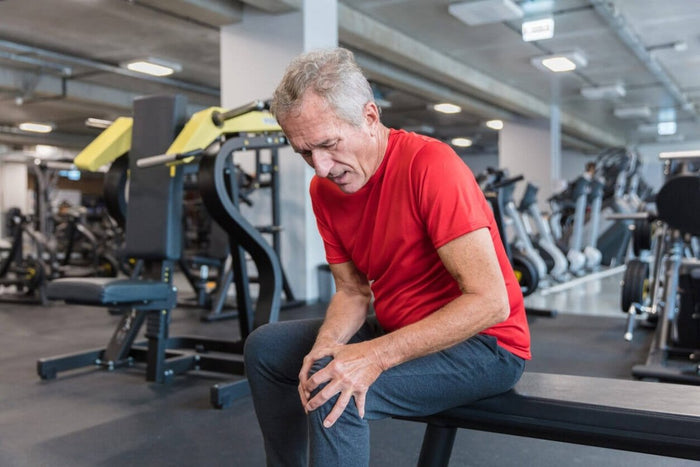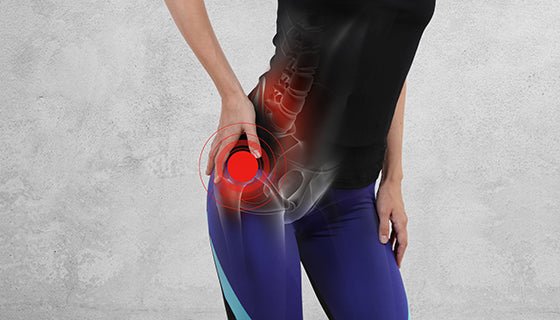UNDERSTANDING KNEE PAIN

What is Knee Pain?
Knee pain is a term used to describe conditions or issues that lead to discomfort around the knee joint. Numerous injuries to structures can lead to knee pain, including the joint, muscle, cartilage and ligaments. Examples of knee pain conditions include arthritis and anterior cruciate ligament (ACL) tears.
Knee pain is one of the leading physical health problems in Australia. According to the Royal Australiasian College of Physicians, up to 35% of Australian adults will experience knee pain (Wiley). Trends from this study also point out that knee pain increases with age. Especially after the age of 70, people are 39-69% more likely to live with knee arthritis (E Clinincal Medicine).
Pain is categorised as either acute, subacute or chronic knee pain
Acute knee pain: (0 days - 6 weeks)
Acute knee pain is pain that lasts anywhere from a few days, up to six weeks. The cause of acute knee pain is usually a minor injury, like a muscle strain or ligament sprain. Of course, not all pain is associated with damage, sometimes just sleeping awkwardly or doing something else may flare it up without any structural damage. This type of pain usually resolves itself with movement and appropriate rest.
Subacute knee pain: (6 weeks - 3 months)
Sub-acute knee pain usually results from acute pain that doesn’t quite resolve. This can be due to more serious injury or sometimes a poor recovery. If you are still aggravating your knee pain with painful movements then it may take longer to heal and recover.
Chronic knee pain: (3 months +)
Chronic knee pain is defined as pain that lasts longer than three months. Chronic pain is usually more complex and can be difficult to treat. There are usually multiple factors leading to the development of chronic knee pain, such as other injuries or health issues. Stress, lack of sleep and other lifestyle factors like obesity can increase the likelihood of chronic knee pain.
What are the symptoms of knee pain?
Knee pain is the primary symptom that may indicate a condition affecting the knee joint or surrounding tissues. These symptoms can vary from a mild and dull ache right through to sharp and stabbing pain. Knee pain is most commonly felt at the front of the knee or can be felt "in the knee".
Common complaints of pain in the knee
- Swelling around the knee joint
- Pain
- Tenderness
- Difficulty bending and straightening the knee
- Feeling of instability or “giving away” of the knee
- Knee cap tenderness
- Grinding pain when bending
- Popping or clicking sound during knee movements
People may experience
Pain areas: in the knee, calf, or thigh, muscles and bones
Sensory: calf numbness or pins and needles
Also common: instability or weakness
What causes knee pain?
Knee pain is commonly caused by injury to either the muscles, ligaments or bones that form the knee joint. Muscle and ligament injuries are usually caused from accidents and sporting injuries, whereas bone related problems usually occur over time and with age, such as osteoarthritis.
According to MedicineNet (Medicine Net), knee pain is defined as “pain that originates in any of the bony structures compromising the knee joint (femur, tibia, fibula), the kneecap (patella), or the ligaments, tendons, and cartilage (meniscus) of the knee.”
Knee pain can result from an issue in one or several parts of the knee, including:
- Muscles (strain)
- Ligaments (sprain)
- Nerves
- Bone injuries - in the knee, the bones are the femur (top of knee), tibia (bottom of knee) and patella (knee-cap).
Common reasons why people experience pain in the knee
- Sitting for a prolonged time
- Sporting injuries
- Arthritis or inflammation of the joints
- Obesity or general poor health.
This list of causes is only a fraction of the possibilities, with many factors contributing to the possibility of knee pain.
Common injuries that cause knee pain
Patella tendonitis
Patella tendonitis is also known as jumper’s knee. It is the inflammation of your patella tendon which connects the kneecap to your shin bone. This occurs particularly with overuse and in sports like running.
Sprained ligament
Tears and damages to the knee’s ligaments are usually caused by direct impact to the knee or a sudden twisting motion of the knee during acceleration. An ACL injury is one of the most common injuries in contact sports.
Torn meniscus
Similar to a sprained ligament, this can happen with high pressure and a rotational force on the knee joint. Meniscus tears usually occur along with ligament injuries.
Osteoarthritis
Osteoarthritis happens when the cartilage that serves as a cushion in the joints wears down over time. As we get older, stress and microdamage accumulates in the cartilage of the knee joints.
Kneecap dislocation
It is often caused by a sudden change in direction while the leg is planted on the ground. Kneecap dislocation can also be caused by a direct blow to the knee cap.
Fractures
Fractures are rare, but they do happen, usually in the case of extreme force directed to the knee like a large fall. Some conditions which result in brittleness or a decrease in bone density can also increase the risk for bone fracture (e.g., osteoarthritis).
Common conditions that cause knee pain
Some conditions may cause knee pain. If you have any of these conditions, knee pain could be one of the symptoms:
- Rheumatoid Arthritis
- Lupus
- Psoriasis
- Osteoarthritis
- Gout
Sports that increase the risk of knee pain
Previously, we listed some of the more common causes of knee pain, like prolonged sitting or osteoarthritis. However, knee pain may also occur when playing sports.
Sporting events that rely heavily on agility put a tremendous amount of stress on the knee joint and the structures around it, resulting in potential injury or pain over time. Here is a list of the most common sports that result in knee pain:
- Basketball
- Football
- Gymnastics
- Competitive cheerleading
- Running
- Soccer
- Tennis
Other risk factors include
Knee pain can occur at any stage of life, even in teenagers and children. However, these risk factors might increase your likelihood of getting knee pain:
- Excess weight - Being overweight or obese increases the mechanical load on your knees, even during basic activities like walking or taking the stairs. It also increases your risk of osteoarthritis by accelerating the breakdown of joint cartilage.
- Lack of muscle flexibility or strength - Having poor flexibility or weakness of the knee muscles can be a risk factor for knee pain. Strong muscles help maintain good control and protect your joints from injury, and muscle flexibility can help you achieve full range of motion.
- Certain sports or occupations: - There are obvious sports that put more stress on your knees than others. Skiing is a likely problem, with stiff boots and fast turning actions. Basketballers are at risk with jumps and pivots, combined with the fast-paced running up and down the court. Working in construction or other highly physical jobs can also increase the risk of knee pain.
- Previous injury - Recurrences of knee pain are unfortunately more likely once you have injured your knee. Good rehabilitation is the key to preventing that!
Consider Orthotics to Prevent Exercise-Related Injury
Sometimes the structure of your body (biomechanics) increases your injury risk. That means even the best athletic shoes won’t protect your feet when you exercise. If your feet are flat, if your arches are too high or if your legs are different lengths, you may need extra support. Customizeable Orthotic insoles such as SelectFlex could be your solution. SelectFlex are an entirely new type of dynamic energy returning insole that won ISHN’s award for Best Foot Protective Product of 2020.
Follow Us











